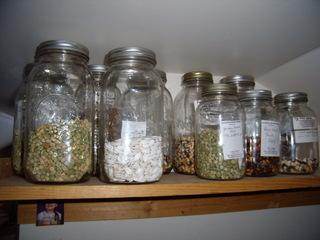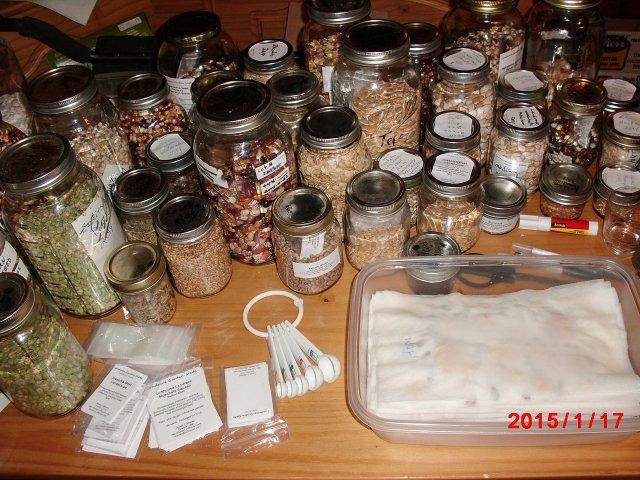My organization method is akin to chaos theory, or successive approximation.
I save my own seeds from about 70 varieties of vegetables from around 55 species. So I have a lot of seeds. My seed 'packets' might consist of anything from a plastic bag containing a single super-special seed, to glass jars containing hundreds of thousands of seeds, to 5 gallon buckets full of seed.
For long term storage of bulky seeds like squash, beans, corn, or peas, they get stored in one or two quart jars on a shelf. Sometimes in one gallon jugs in the freezer.
For small seeds like tomatoes, peppers, etc, where there isn't much seed, and it isn't bulky, they get stored in plastic bags in trays. There are about 8 trays represented here. One contains only tomatoes, one contains okra, one contains seeds that people send me that I want to plant. One contains sibling-group packets of squash. Just enough for me to plant in the spring. The bulk squash seed is stored on the shelf. One contains odds and ends.
Because I am a plant breeder, I like to grow fresh seed every year, while maintaining an archive/backup copy of my garden. So packets of seed that have been to the field with me, and had some taken out for planting, and some left -over, get dumped into a bin. I may never look at those seeds again until I feed them to the chickens.
These are seeds that I'm working with today for germination testing... They can sit on the floor for a week while the test is in progress.
Bulk lots of beans and corn are stored in 5 gallon buckets with screw on lids.
I use lots of sizes of glass bottles in order to fit the amount of seeds being stored:
While it isn't obvious from the photos. I store seeds together by approximate planting date.. For example: The tomatoes, peppers, okra, tomatillos, and eggplant are stored together because I start them in the greenhouse some weeks before our last spring frosts.
The carrots, beets, radishes, turnips, chard, brassicas, spinach, and peas are stored together because I plant them in early spring.
The beans, squash, and melons are stored together because they are planted after all danger of frost.
I've been farming my whole life, so I wing it with planting dates based on experience and how the season is progressing.
My planting dates and crops are:
March 21st, or within a day or two of snow melt.
wheat/rye if I didn't already plant them in the fall.
Onion sets.
Direct seeded peas.
fava transplants, about 3 weeks old.
bok choi
spinach
mid-april
cold weather crops like
brassicas,
carrots,
parsnips,
small onion transplants and/or more sets
fennel,
beets,
chard,
Turnips
and perhaps frost tolerant trials of crops that are totally out of season like corn, tomatoes, etc.
Start the tomatoes and peppers in the greenhouse.
Shortly before/after dig up the root pit and get the seed crops planted.
May 5th
Corn planting day, and potato tubers.
Also an early (possibly-sacrificial) crop of zucchini/crookneck.
June 5th, about 10 days after average last frost.
Day for planting squash, beans, melons, and a second crop of sweet corn.
Set tomato, okra, eggplant, and peppers transplants into the field.
Some years I plant a third crop of sweet corn about June 15th.
I don't have my planting dates for greenhouse things memorized since this is only my second year with an honest greenhouse. I end up calculating those. I hope that I can find last year's notes. I did a really good job of having things ready on time.
I grow my own seeds. If I don't currently have a species, or I want to add some diversity to it, I swap with someone. I attend local seeds swaps. I visit friends that grow seed. I swap with Internet pals. If I buy seeds, it's from a human being that grew the seeds on her own farm. I decided some years ago that I do not like the corporate model of commerce. So I don't buy seeds from big companies. I'm not going to throw away my line of open pollinated Sungold tomatoes just because it originated with The Corporation. The plant itself is pure regardless of it's origins.
I used to keep detailed records. Eventually I was spending more time keeping records than growing crops. I realized that I could grow twice as much food if I stopped keeping records. That was an easy choice to make and I haven't regretted it. I wasn't referring back to the records anyway. And if I did, there were too many records to sort through to find what I wanted. Photography of the garden has become my primary documentation method. I might write down something from time to time, but only the most critical things.
I save most seeds in bulk... For example, I grew about 300 varieties of beans this year. Most of the seed got saved into a single 5 gallon bucket. I saved perhaps 50 varieties into packets containing around 30 seeds each. That will let me plant them together next summer, so that I can explore the variety more fully next summer.
I grew about 200 varieties of tomatoes this year. I saved perhaps 30 varieties as sibling-groups, meaning that all the seed in a packet came from the same mother. The other 170 varieties got saved only as bulk seed.
Genetic diversity works for me. Inbreeding purity doesn't. First thing I do when I start growing a new species is induce a few different varieties to promiscuously pollinate. The variety that is 'right' for me is the one that grew well enough to produce seed in my garden last year.

 1
1



































 7
7










 1
1




 1
1




 2
2











 2
2




 2
2




![Filename: blackbeanseeds.jpg
Description: Cherokee Trail of Tears Black Beans [Thumbnail for blackbeanseeds.jpg]](/t/53043/a/35754/blackbeanseeds.jpg)
 1
1













 2
2




 1
1











 1
1





 1
1



















 1
1














